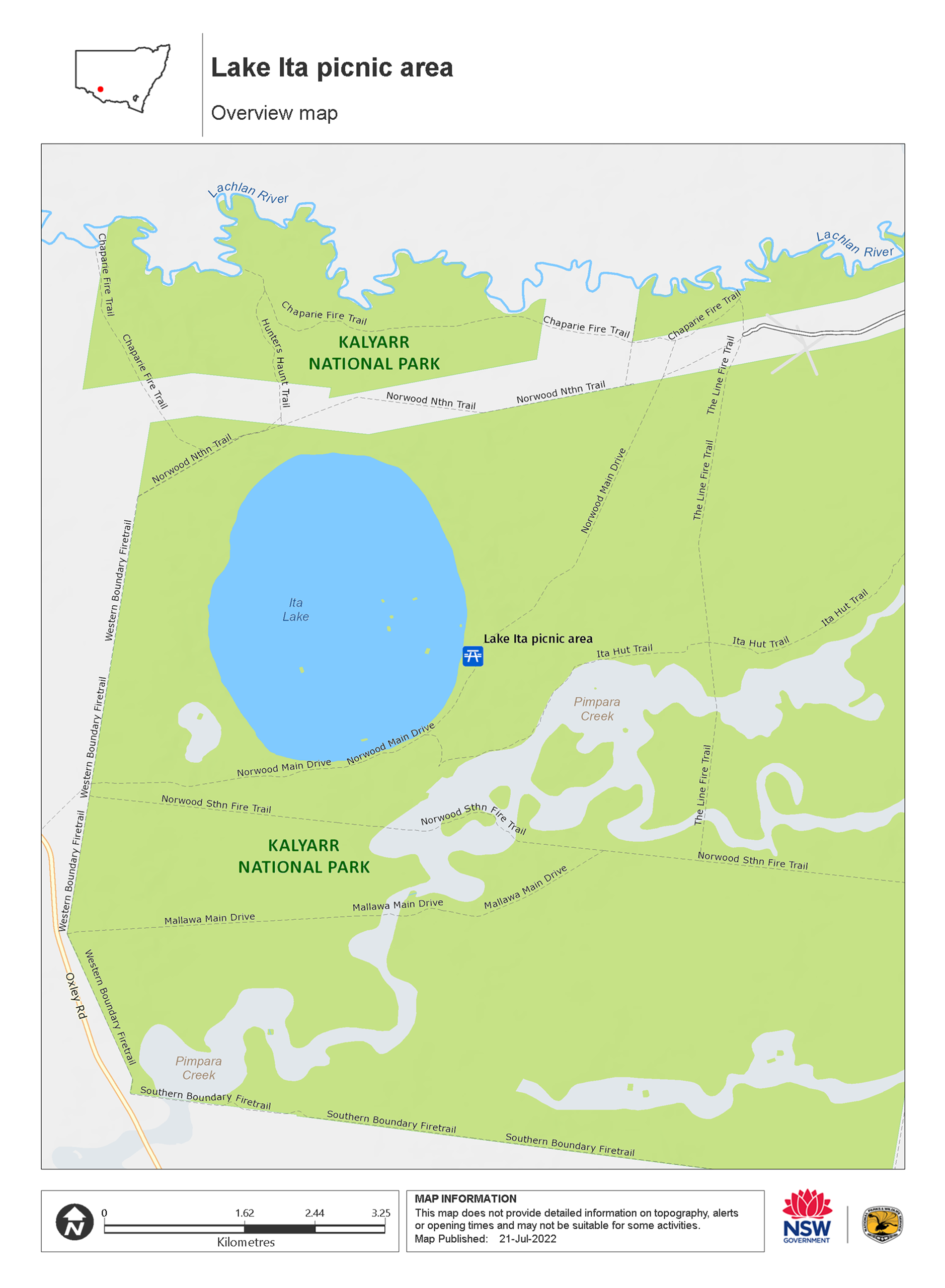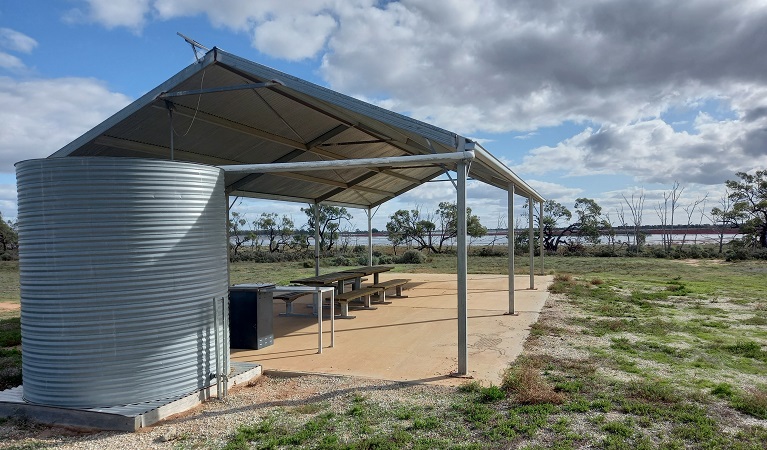Lake Ita picnic area
Kalyarr National Park
Overview
Lake Ita picnic area is a great spot for lunch and birdwatching. Nestled beside Ita Lake in Kalyarr National Park, it’s ideal if you’re staying in Hay or on your way to Mungo or Yanga National Park.
- Type
- Picnic areas
- Where
- Kalyarr National Park in Murray-Riverina
- Accessibility
- Medium
- Grade
- Easy
- What to
bring - Drinking water, cooking water, food supplies
Set on the eastern shore of Ita Lake, you’ll find Lake Ita picnic area a secluded spot to relax and unwind. Enjoy a picnic lunch or barbecue, then take a walk around the lake and admire the peaceful surroundings and local wildlife. If you stay later in the day you can enjoy a spectacular sunset, as you sit back and soak up the view over the lake and the black box woodland around it.
Lake Ita picnic area is excellent for birdwatching. In wet years the lake fills with water and becomes a haven for water birds like black swans and red-necked avocets, as well as southern bell frogs. In dry years the lake transforms into a flat expanse of grass and saltbush, and you can see emus and red, eastern grey and western grey kangaroos roaming the area.
The picnic area is also an important cultural centre for the Nari Nari people. The site and the areas surrounding it have great cultural and historical significance for them
The best times to visit are autumn and spring. The weather is milder and the area comes alive with wildflowers, including billy buttons, paper daisies, colourful water ferns, native bluebells and speargrass. In spring, bright pink pig’s face flowers are particularly abundant.
Map

Map legend

Local alerts
For the latest updates on fires, closures and other alerts in this area, see https://www.nationalparks.nsw.gov.au/things-to-do/picnic-areas/lake-ita-picnic-area/local-alerts
General enquiries
- National Parks Contact Centre
- 7am to 7pm daily
- 1300 072 757 (13000 PARKS) for the cost of a local call within Australia excluding mobiles
- parks.info@environment.nsw.gov.au
Park info
- in Kalyarr National Park in the Murray-Riverina region
Kalyarr National Park is always open but may have to close at times due to poor weather or fire danger.
Visitor info
All the practical information you need to know about the Lake Ita picnic area.
Maps and downloads
Learn more
Lake Ita picnic area is in Kalyarr National Park. Here are just some of the reasons why this park is special:
Country of the Nari Nari People

Kalyarr is the traditional Country of the Nari Nari People. Aboriginal people have lived here for at least 40,000 years and there are thousands of stone artefacts, scar trees, hearths, middens and mounds throughout the park. Today Nari Nari people advise on park management and share their traditional knowledge with the community. Explore the Kalyarr cultural trail to learn more about the park’s cultural landscape.
One of the flattest places on earth

Kalyarr is located on the Riverine Plain. The plain is incredibly flat and its vast open landscape is starkly impressive. Other than the Lachlan River, there is no permanent natural water on Kalyarr, but in wet years patchy ephemeral wetlands form in lakes, creeks and gilgais. There are no rock outcrops in the park, and few stones. Aboriginal people traded for stone to make tools and used alternatives such as clay for cooking.
A refuge for native animals

Kalyarr supports a large expanse of saltbush and shrublands that thrive in the semi-arid environment where trees struggle. On the richer soil along rivers and creeks, there are woodlands of river red gum, black box, river cooba and myall. Kalyarr is an important refuge for native animals in a heavily cleared landscape, and is home to several rare and threatened species like the plains-wanderer. Birdwatchers can look out for spectacular arid-zone species like pink cockatoos and orange chats.
Graziers and shearers

The first European explorer to visit the area was John Oxley in 1817, followed by Charles Sturt along the Murrumbidgee in 1829. These expeditions led to the displacement of Aboriginal people and settlement by Europeans, who established a successful wool industry. Historic buildings relating to the former pastoral properties of Norwood, Darcoola, Corrong and Thelangerin are preserved in the park. They showcase the self-sufficient life of graziers during the late 19th and 20th centuries and give an insight into the challenges of living and working as a shearer on these stations.
Plants and animals protected in this park
Animals
-

Eastern blue-tongue lizard (Tiliqua scinciodes)
The eastern blue-tongue lizard, one of the largest skinks in Australia, is found throughout most of NSW. When threatened, the eastern blue-tongue lizard displays its blue tongue in a wide-mouthed intimidating show. Not an agile animal, they feed on slow-moving beetles and snails.
-

Emu (Dromaius novaehollandiae)
The largest of Australian birds, the emu stands up to 2m high and is the second largest bird in the world, after the ostrich. Emus live in pairs or family groups. The male emu incubates and rears the young, which will stay with the adult emus for up to 2 years.
-

Kookaburra (Dacelo novaeguineae)
Of the 2 species of kookaburra found in Australia, the laughing kookaburra is the best-known and the largest of the native kingfishers. With its distinctive riotous call, the laughing kookaburra is commonly heard in open woodlands and forests throughout NSW national parks, making these ideal spots for bird watching.
-

Lace monitor (Varanus varius)
One of Australia’s largest lizards, the carnivorous tree-dwelling lace monitor, or tree goanna, can grow to 2m in length and is found in forests and coastal tablelands across eastern Australia. These Australian animals are typically dark blue in colour with whitish spots or blotches.
-

Red kangaroo (Macropus rufus)
The red kangaroo is one of the most iconic Australian animals and the largest marsupial in the world. Large males have reddish fur and can reach a height of 2m, while females are considerably smaller and have blue-grey fur. Red kangaroos are herbivores and mainly eat grass.
-

Short-beaked echidna (Tachyglossus aculeatus)
One of only 2 egg-laying mammals in the world, the short-beaked echidna is one of the most widespread of Australian native animals. Covered in spines, or quills, they’re equipped with a keen sense of smell and a tube-like snout which they use to break apart termite mounds in search of ants.
-

Southern boobook (Ninox novaeseelandiae)
The southern boobook, also known as the mopoke, is the smallest and most common native owl in Australia. With a musical 'boo-book' call that echoes through forests and woodlands, the southern boobook is a great one to look out for while bird watching.
-

Superb fairy wren (Malurus cyaneus)
The striking blue and black plumage of the adult male superb fairy wren makes for colourful bird watching across south-eastern Australia. The sociable superb fairy wrens, or blue wrens, are Australian birds living in groups consisting of a dominant male, mouse-brown female ‘jenny wrens’ and several tawny-brown juveniles.
-

Tawny frogmouth (Podargus strigoides)
Found throughout Australia, the tawny frogmouth is often mistaken for an owl due to its wide, powerful beak, large head and nocturnal hunting habits. The ‘oom oom oom’ call of this native bird can be heard echoing throughout a range of habitats including heath, woodlands and urban areas.
-

Wedge-tailed eagle (Aquila audax)
With a wingspan of up to 2.5m, the wedge-tailed eagle is Australia’s largest bird of prey. These Australian animals are found in woodlands across NSW, and have the ability to soar to heights of over 2km. If you’re bird watching, look out for the distinctive diamond-shaped tail of the eagle.
-

White-bellied sea eagle (Haliaeetus leucogaster)
White-bellied sea eagles can be easily identified by their white tail and dark grey wings. These raptors are often spotted cruising the coastal breezes throughout Australia, and make for some scenic bird watching. Powerful Australian birds of prey, they are known to mate for life, and return each year to the same nest to breed.
-

Common brushtail possum (Trichosurus vulpecula)
One of the most widespread of Australian tree-dwelling marsupials, the common brushtail possum is found across most of NSW in woodlands, rainforests and urban areas. With strong claws, a prehensile tail and opposable digits, these native Australian animals are well-adapted for life amongst the trees.
-

Brown-striped frog (Lymnastes peronii)
One of the most common frogs found in Australia, the ground-dwelling brown-striped frog lives in ponds, dams and swamps along the east coast. Also known as the striped marsh frog, this amphibian grows to 6.5cm across and has a distinctive ‘tok’ call that can be heard all year round.
Plants
-

Billy buttons (Craspedia spp. )
Billy buttons are attractive Australian native plants that are widespread throughout eastern NSW in dry forest, grassland and alpine regions such as Kosciuszko National Park. The golden-yellow globe-shaped flowers are also known as woollyheads. Related to the daisy, billy buttons are an erect herb growing to a height of 50cm.
-

River red gum (Eucalpytus camaldulensis)
Australian native plants, majestic river red gum trees are widespread across Australian inland river systems. The river red gum is a dominant tree species of the Murray-Darling basin which spans NSW, Queensland and Victoria. This iconic native eucalypt grows to a height of 30m and is thought to have a lifespan up to 500-1000 years.
-

Saltbush (Atriplex nummularia)
A hardy Australian native plant, the saltbush is a small spreading shrub that can withstand dry salty soils such as those found in the desert plains of western NSW. It is grey-white in colour and has small spear-shaped succulent leaves. It flowers from December to April.

